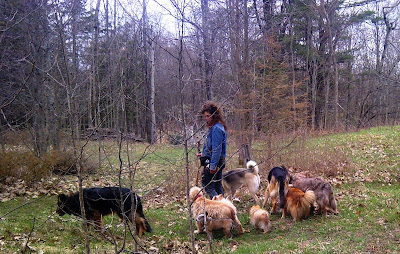UNPROVOKED DOG BITES - REALLY?
First, I believe it is always important to
define what is meant by bite.
Not for those who are familiar with working with dogs, but more for those who
have not had to deal with such things or are new to living with a dog.
When we say 'bite', what is meant? Do we mean break the skin & sink teeth in; are we including a nip, leaving no impression in the skin or a tiny mark?
I have a pack of ten dogs, and at one time or another they have all done the bite thing (leaving an impression in the skin or a tiny mark). All they needed was to be instructed the right way not to do this and repetition of incident was not an issue.
When we say 'bite', what is meant? Do we mean break the skin & sink teeth in; are we including a nip, leaving no impression in the skin or a tiny mark?
I have a pack of ten dogs, and at one time or another they have all done the bite thing (leaving an impression in the skin or a tiny mark). All they needed was to be instructed the right way not to do this and repetition of incident was not an issue.
We have many means to express ourselves and
protest especially with that opposable thumb of ours! Dogs have their mouth,
paws and legs to express protest.
As a Dog Whisperer, I also work with Red Zone' dogs who have broken the skin and sunk teeth in - this is not the same as 'leaving an impression in the skin or a tiny mark'. I rehabilitate the red zone dogs. The surrounding circumstances and details of each situation need to be considered.
If we are talking about a red zone dog bite that is one thing. But I believe a nip is a very different thing - easily addressed and when properly done so, re occurrence is normally not an issue. This is just my opinion, based on years of working with dogs and people & their dogs
As a Dog Whisperer, I also work with Red Zone' dogs who have broken the skin and sunk teeth in - this is not the same as 'leaving an impression in the skin or a tiny mark'. I rehabilitate the red zone dogs. The surrounding circumstances and details of each situation need to be considered.
If we are talking about a red zone dog bite that is one thing. But I believe a nip is a very different thing - easily addressed and when properly done so, re occurrence is normally not an issue. This is just my opinion, based on years of working with dogs and people & their dogs
It is my experience that issues with dogs start with their
people. Very, very few instances of a dog biting are unprovoked. The problem
resides in the narrow definition we often employ in using the word ‘provoked’.
PROVOCATION
CAN BE BROKEN DOWN IN TO TWO TIMELINES - IMMEDIATE & ACCUMULATED
Immediate
provocation may be very evident to all people.
Immediate provocation may also be only evident to those who really understand
and truly know how to read, interpret, establish the pathology of dog behaviour
and understand the psychology of dogs. I see both instances in my work with
people and their dogs. The result is a lot of assumption, emotion,
mis-interpretation and miss understanding….of the dog.
Accumulated provocation
is something that may be clearly evident (i.e. the dog is taunted repeated on
separate occasions. On the other hand accumulated provocation may be very
difficult for most people to identify. If the dog’s human companions have never
(or have ineffectively) embraced the role of leadership in their dog’s life,
the effect overtime is provocation. The lack of a) rules, boundaries and limitations,
and b) respectful consistent direction, correction, follow through (coaching
& mentoring); is provocation over time. Just as it would result in a human
acting out, so to for a dog.
When we pass the dog to someone else - we just
pass the problem on. When we summarily euthanize the dog we are making a huge
mistake.
When we do not take the opportunity to correct the dog in a
respectful, firm way without anger, fear or other emotions we create
psychological damage in the dog. We miss an opportunity to change future
outcomes - we make one more mistake in the dogs’ life - we set the dog up for
future failure…just as we would be doing with a human. I help people and their
dogs repair this type of issue all of the time.
There are very few dog attacks that are
not-unprovoked…it is just that no one was there at the right time to intervene
in the right way when the provocation first started to build.
A dog that nips has already been let down by humanity - it
does not need to be euthanized, it does not want to be bad - it just wants
someone to step up to the plate and provide it with kind, considered direction.
If not addressed in time the nip eventually
turns to a bit and the bite can turn into a deathly compressive lockdown. Not
the dogs fault - humanities fault.
For those who have suffered from traumatic dogs bites
(either human or animal companions), for those who have died as a result of an
attack by a dog and for their loved ones who are left to try to understand - it
is a tragic and life altering situation. But 99.9% of this time it is the
humans behind the reactive dog who are at fault - not the dog who is euthanized.
Very few dogs are born with 'bad wiring'.
Because dogs live in the moment it is easier to change a dog's 'bad habits' than it is a
human's. Humans carry grudges, dogs do not. Dogs are very forgiving and treat
each day, each experience as a new beginning. It is only with difficulty that
we are able to convince, permit and allow ourselves to do the same.
Many of my client’s come to me as a last resort before
making the decision to euthanize their dogs. Not one of the dogs I have worked
with to date required euthanasia - they were not hopeless cases, they just had
not received the direction that they asked for and were left to make up their
own rules. I most cases one four hour session with me was all that was required
to turn the situation around.
If your dog shows signs of reactivity - is nipping or
biting…get help, don’t ignore. Get help. But make sure that you get the right
help - e-collars, prong collars are not beneficial tools to address this
situation, neither is trying to break the state with treats.
Patience, will, determination, persistence,
respect and an understanding of dog and human psychology are key. Coach and
mentor the dog, train the people.
Additional Assistance
Holistic Wellness and Behaviorist Services
Do you need holistic advice to support your companion animal's health and well being? Become a client. Book your consultation. My professional holistic nutrition, wellness and behavioral services are available to you:
🌿 Holistic Wellness Services for Dogs and Cats 🐕 🐈
🌿 Holistic Behaviorist Services for Dogs 🐕
My Holistic Client Services are Available Worldwide:
🇺🇸 USA
🇨🇦 Canada
🇬🇧 UK and other European countires
🇦🇺 Australia and other Oceania countires
🇭🇰 Hong Kong and other Asian countries
🇨🇷 Costa Rica and other Central American countries
🇪🇺 European countries
🇹🇹 Trinidad and Tobago and other South America countries
🇿🇦 South Africa and other African countries
🇸🇪 Sweden and other european countries
🇦🇪 United Arab Emirates
Available Holistic Consultations and Sessions:
📱 FaceTime
📱 Facebook video or voice calling
💻 Skype
📞 Phone
📧 Email
🚶🏻♀️ In-Person
Menu of Holistic Wellness Services for Dogs and Cats 🐕🐈
For more information go here.
✅ Maintain Health, and;
✅ Address Health Issues and Conditions:
✓ Treatment and Remedy
✓ Pre-Surgery holistic support protocols
✓ Post-Surgery holistic healing protocols
✓ Pre-Vaccine holistic support protocols
✓ Post-Vaccine holistic support protocols
✓ Natural Insect and Parasite Prevention
✓ Natural Treatment for Insect, Parasite Infestation, Co-Infection, Disease
✅ Custom Designed Whole Food Diets - raw or gently cooked, and;
✅ Advice and Recommendation:
✓ Premade Diets - raw, dehydrated, freeze dried
✓ Supplemental Fresh Foods - raw, gently cooked
✓ Super foods
✓ Treats - raw, dehydrated, freeze dried, gently cooked
✓ Herbs
✓ Alternative Medicines
Menu of Holistic Behaviorist Services for Dogs 🐕
For more information go here.
In-person Sessions - available locally
Voice and Video Sessions - available worldwide
✓ Obedience Training
✓ Behavior Modification
✓ Psychological Rehabilitation
Affiliations to Companies
✓ None.
✓ I don't sell food or supplements.
✓ I'm not aligned with any companies.
✓ I choose to maintain my objectivity in selecting best-solutions for my individual client's needs.
Contact me
karen@ottawavalleydogwhisperer.ca
Article and graphics by Karen Rosenfeld
Do you need holistic advice to support your companion animal's health and well being? Become a client. Book your consultation. My professional holistic nutrition, wellness and behavioral services are available to you:
🌿 Holistic Wellness Services for Dogs and Cats 🐕 🐈
🌿 Holistic Behaviorist Services for Dogs 🐕
My Holistic Client Services are Available Worldwide:
🇺🇸 USA
🇨🇦 Canada
🇬🇧 UK and other European countires
🇦🇺 Australia and other Oceania countires
🇭🇰 Hong Kong and other Asian countries
🇨🇷 Costa Rica and other Central American countries
🇪🇺 European countries
🇹🇹 Trinidad and Tobago and other South America countries
🇿🇦 South Africa and other African countries
🇸🇪 Sweden and other european countries
🇦🇪 United Arab Emirates
Available Holistic Consultations and Sessions:
📱 FaceTime
📱 Facebook video or voice calling
💻 Skype
📞 Phone
🚶🏻♀️ In-Person
Menu of Holistic Wellness Services for Dogs and Cats 🐕🐈
For more information go here.
✅ Maintain Health, and;
✅ Address Health Issues and Conditions:
✓ Treatment and Remedy
✓ Pre-Surgery holistic support protocols
✓ Post-Surgery holistic healing protocols
✓ Pre-Vaccine holistic support protocols
✓ Post-Vaccine holistic support protocols
✓ Natural Insect and Parasite Prevention
✓ Natural Treatment for Insect, Parasite Infestation, Co-Infection, Disease
✅ Custom Designed Whole Food Diets - raw or gently cooked, and;
✅ Advice and Recommendation:
✓ Premade Diets - raw, dehydrated, freeze dried
✓ Supplemental Fresh Foods - raw, gently cooked
✓ Super foods
✓ Treats - raw, dehydrated, freeze dried, gently cooked
✓ Herbs
✓ Alternative Medicines
Menu of Holistic Behaviorist Services for Dogs 🐕
For more information go here.
In-person Sessions - available locally
Voice and Video Sessions - available worldwide
✓ Obedience Training
✓ Behavior Modification
✓ Psychological Rehabilitation
Affiliations to Companies
✓ None.
✓ I don't sell food or supplements.
✓ I'm not aligned with any companies.
✓ I choose to maintain my objectivity in selecting best-solutions for my individual client's needs.
Contact me
karen@ottawavalleydogwhisperer.ca
Article and graphics by Karen Rosenfeld
Notes:
Please note - this article is for information purposes and is not a
substitute for an in-person Session with me. When working with dogs I use many
techniques - it is important to note that this article may touch on one or
several techniques but not all. I select the technique that I use for a particular
dog based on my observations of the dog and an intuitive, instinctive
assessment of that dog's and its human's individual requirements. For example
when I am working with a dog that is hyper sensitive and very physically
reactive I will not use voice or touch. I use a lot of therapeutic touch on
some dogs, others require the use of herding techniques and so on. Each and
every technique must be combined with:
- an understanding of the real intelligence, sensitivity and capability of dogs;
- an understanding of how to read a dog's face and a dog's overall body language;
- an understanding of the full spectrum of ways that humans communicate and dogs communicate;
- understanding and recognition of the individual that is each dog - no two dogs are the same...taking a 'cookie cutter' approach to techniques is not the way to work with a dog;
- a complete recognition and understanding of all the elements that feed a behaviour and create an issue:
- the vast majority of people can only identify one or two elements...which vastly inhibits the ability to resolve behavior issues;
- behaviours do not exist in isolation - there are always many elements that feed a single behaviour, there all always multiple behaviours that create a behavioral issue;
- self-restraint and discipline on the part of the human who is directing the dog;
- sensitivity, awareness, intuition, instinct and timing on the part of the human who is directing the dog;
- to understand, connect with and adapt quickly and effectively to a dog's learning requirements you must be able to employ the same tools a dog uses - acute sensitivity, awareness, instinct, intuition and timing;
- kindness, endurance, consideration, patience, persistence, perspective, the ability and know how to let the past go, the ability to set realistic expectations at any one point in time;
- the creation of structure, rules, boundaries and limitations for each situation at the macro and micro level;
- understanding of all the elements that make up an instruction and direction to a dog...there are multiple steps involved in an instruction - not just one!
- absolute honesty - if you cannot be honest with yourself you will not be able to communicate clearly with a dog.
These are just some of the techniques that I teach my clients - it is a
holistic, all-encompassing approach. If you are missing any one element of the
above mentioned your success rate will be affected to one degree or another in
implementing the techniques offered in the article presented above.










